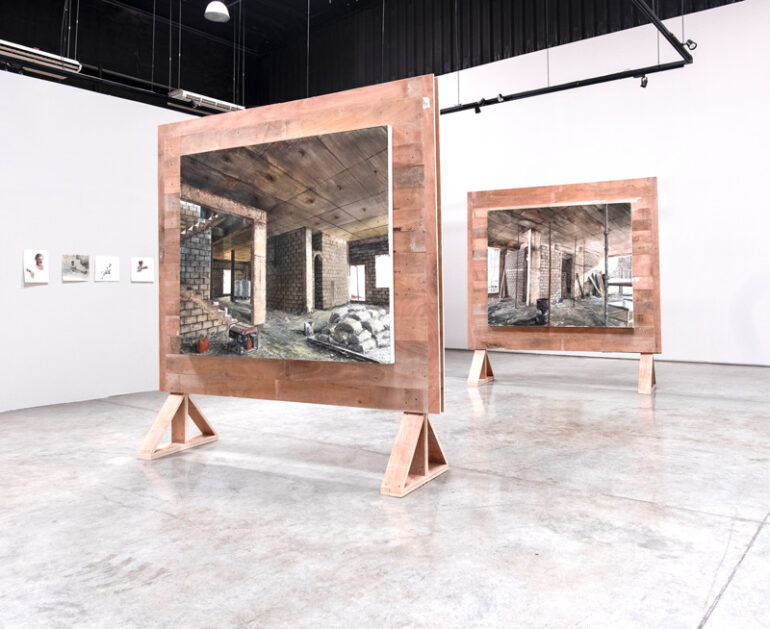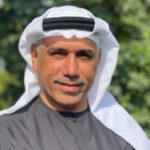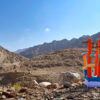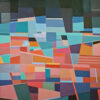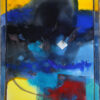- He introduced 12 artworks ranging from small paintings, and medium ones, to huge wall murals at Lyon Biennale 2022
- (Even Their Shades Don’t Belong to Them) is an artistic expression that manifests the fragility of the world, a world that is filled with those who are smashed and, on the margins, with no one to see them or hear their struggles, even those who pass by them
- His mother played a major role in his artistic career, as she paved the way for him to accumulate his talent.
- He befriended rebel poets and artists in the 80s, and he chose modernism in art and in thought.
- He got training in painting workshops, and his journey was crowned by obtaining a Master’s degree in art from the USA.
- He managed to win awards in art since childhood, and his artworks were acquired by major world museums.
- He won the Sharjah Biennale 1998 award, and his way to internationalism started then.
- “The Light in Between” exhibition was one of his most mature and unique art experiences.

More than 12 art pieces, small paintings, medium ones, and other large wall murals were the contributions of Emirati Artist Mohammed Kazem in the 16th Lyon Biennale of Contemporary Art, held in France between September 14 and December 31, 2022. Under the theme “Manifesto of Fragility”, supported by The Ministry of Youth and Culture and Department Of Culture And Tourism – Abu Dhabi, and collaboration with Lyon Biennale. Two other Emirati artists participated along with him; Hashel Al Lamki and Chafa Ghaddar.
This event represents a valuable opportunity for us to explore artist Mohammed Kazem’s technical experience in painting, after years of producing conceptual and installation artworks.
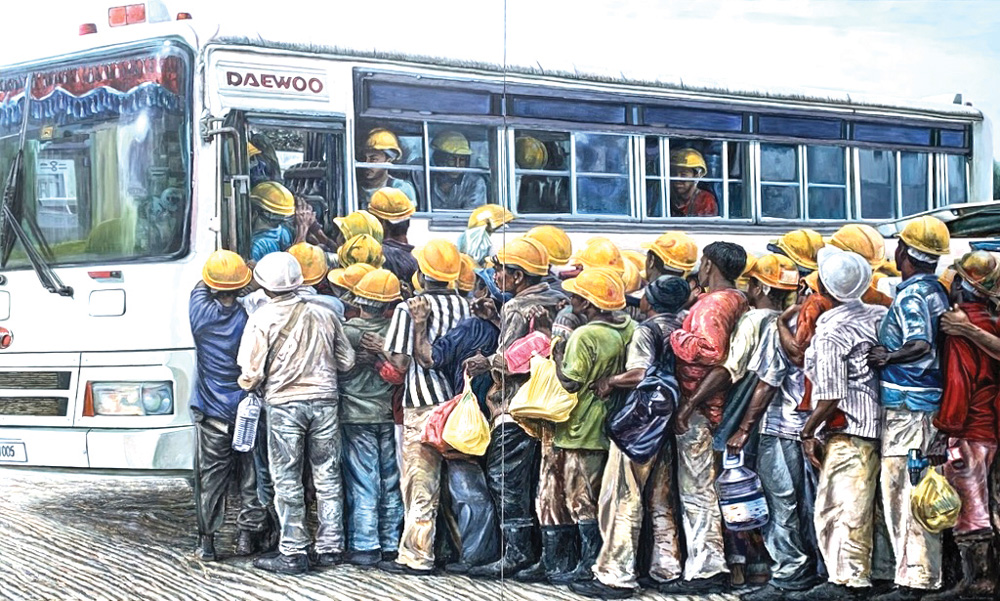
We get to see him back again to producing the art paintings he excelled in creating back in the 80s and 90s, utilizing colors, brushes, and free strokes on canvas. As far as I know, it is quite an important and unprecedented event for the artist to participate with 12 paintings in an international biennale, including huge wall murals. This could be attributed to the artist’s unique experience, and to the generous support he received from the UAE government. Her Excellency Noura bint Mohammed Al Kaabi considered these participations by the three creative Emirati artists the ideal opportunity to showcase the local artists’ projects in this international event, which holds a special and high position among art events. These participations establish the UAE pioneer role and its continuous and influential presence in the different global art events, and consolidate its efforts to introduce the local Emirati and Arab identity to the art-tasting audience.
His excellence Mohamed Khalifa Al Mubarak, Chairman of the DCT Abu Dhabi, stated, “The artists representing the UAE at the 16th Lyon Biennale of Contemporary Art are continuing a proud tradition of sharing our culture with the world. Their participation in the 16th Lyon Biennale of Contemporary Art reflects how proud we are of our identity and deep-rooted cultural heritage, and our genuine desire to share our magnificent art with the world.
Manifesto of Fragility
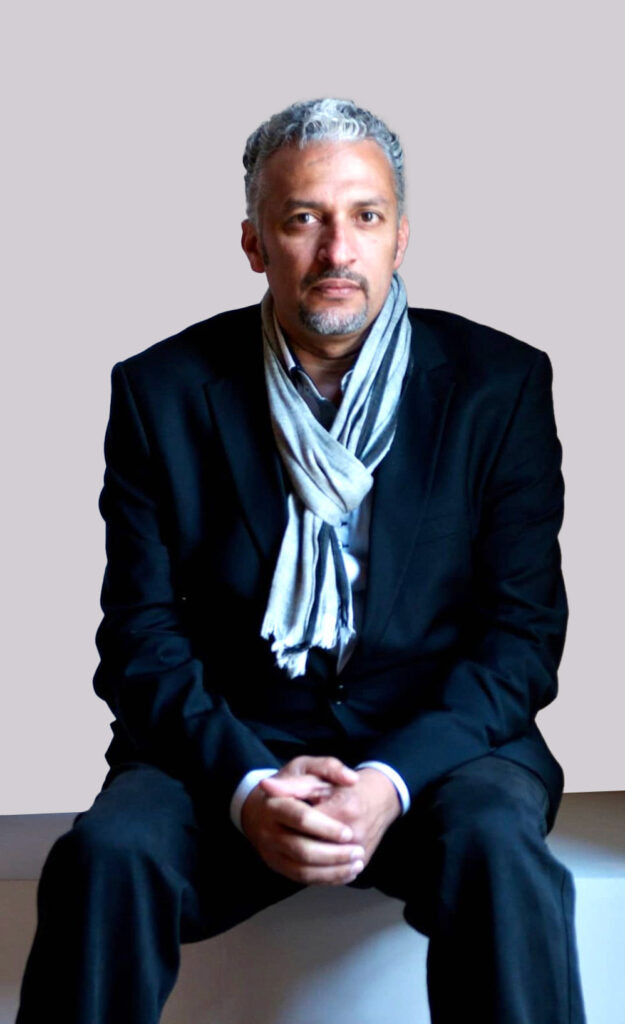
Mohammed Kazem, in his efforts to reflect the exhibition theme “Manifesto of Fragility”, decided to paint a large wall mural of a group of workers stepping into the bus. He spent more than three consecutive months, on a daily basis, painting in his private studio at Alserkal Avenue in Dubai. It is the largest wall mural ever in his long career in art, which lasted more than 35 years. Mohammed used acrylic colors for the mural, while in other paintings, named “even their shades don’t belong to them) he used acrylic colors with ink to furnish the painting with a dark space so that the viewer would see human shapes, in the dark, without shadows. It is an artistic expression that manifests the fragility of the world, a world that is filled with those who are smashed, on the margins, with no one to see them or hear their struggles, even those who pass by them. the reactions there in the expressions tell us that the Emirati participation stood out in this biennale, which have 87 contemporary artists from 39 countries to contribute, and a timeline that encompassed hundreds of art pieces and historic collections which extend back to 200 years, those came as borrowed sets from several art entities inside and outside Lyon.
The Biennale has also introduced an intersect between two axes, with its configuration that is focused on the 60s epoch or what we can call the Golden Age of Beirut, while shedding the light on Lyon’s historic intertwining with the Lebanese capital, in efforts to share with the audience, and in several locations all around the French City, the numerous artistic aesthetics curated by more than 50 specialized committees.
This unique participation seems like the best opportunity to shed the light on Artist Mohammed Kazem’s experience, and his journey with art throughout all these years.
The Moment of Artistic Emergence
The doors of visual arts became wide open to Mohammed while he was still a boy. It happened back around the middle of the 80s, when the Emirati artist Hassan Sharif (1951- September 18, 2016) from Britain, after acquiring a diploma from Byam Shaw School of Art in London, immediately started organizing workshops on painting for youth, at the headquarters of Emirates Fine Arts Society in Sharjah. Mohammed Kazem’s mother noticed her son’s interest in arts, especially painting and music, at the expense of the other subjects in school. She was looking for a center or a society in Dubai, near their house, to enhance his skills, but her efforts did not prevail, until she heard, by chance, one of her relatives going to Sharjah every evening by car, so she suggested that he’d take her 15-year-old son to the society to get painting lessons, and take him home after.
Mohammed Kazem studied under Hassan Sharif and the Society’s other teachers and was introduced to the basic structures of a painting, perspective view, measuring dimensions, and drawing in black and white at first, then gradually using oil paints and watercolor to draw still life. After that, he started moving from one art school to another, from realistic to impressionism to cubism and abstractionism. He started painting by imitating the styles of Matisse and Van Gogh. This was in the times from the middle of the 80s to the middle of the 90s, especially when Hassan Sharif founded the Art Atelier, affiliated with the Ministry of Youth and Sports in Dubai in 1987. It was in close quarters to Mohammed Kazem’s house, so he had easy access to the atelier where he could immerse in this magnificent world.
Along with Poets
Mohammed Kazem, as a boy, loved music, and he acquired, with the support of one of his relatives, a guitar, and he started to practice playing, then, he painted this instrument with love using one of the techniques he learned, and this painting will later become his first real work in the field of visual arts. In an exhibition in 1986 of young Emirati artists, the painting (Guitar-1986) got the first award. Mohammed then traveled to Kuwait, where he represented his country for the first time, and the same painting managed to obtain the first award in a competition for young artists from GULF.
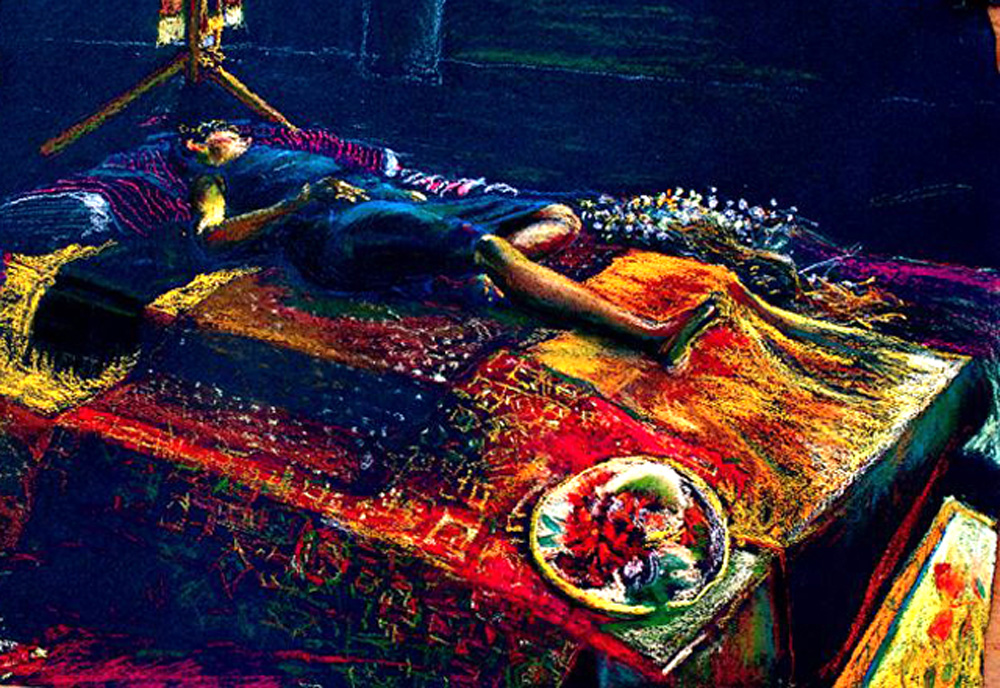

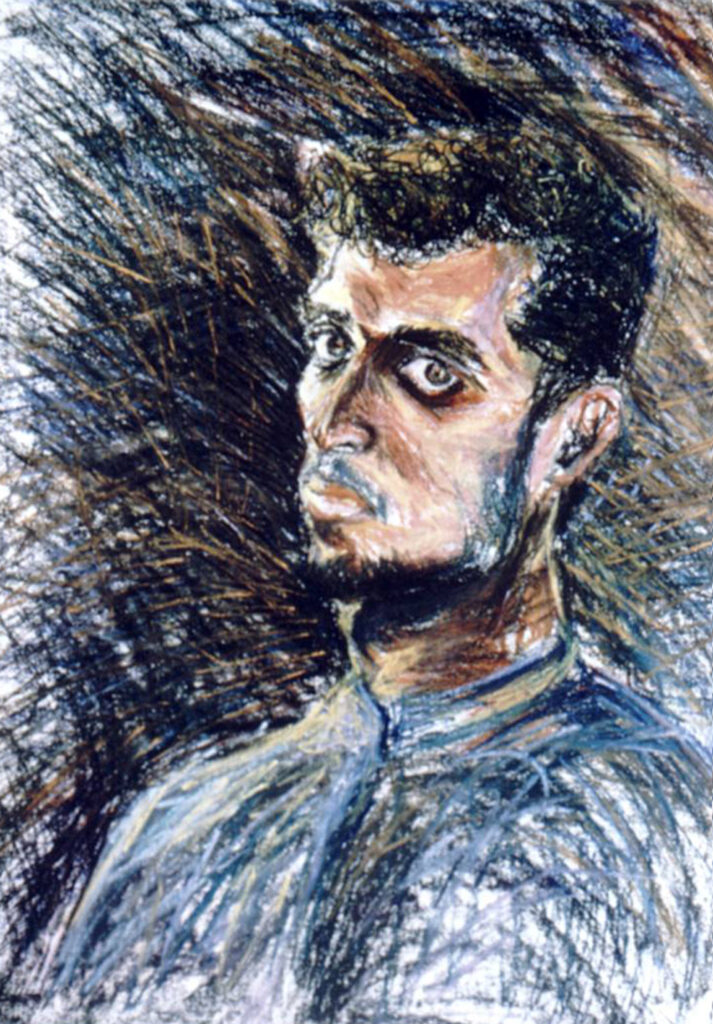


Mohammed did not get the chance to study academically, but he got training in dozens of art workshops that provided theoretical and applied lessons. Through these workshops and reading and following up, he got to learn about old philosophies, art schools, and art theories from classic times to modern ones. His participations in collective galleries for youth were increasing, and he continued to win awards in GULF competitions for young artists. At the same time, he was witnessing the battle of modernism and its battle with traditional movements in the UAE society, where the new thesis and proposed ideas in art were facing huge resistance from tradition advocates, to a point where those who introduced them were accused of ruining the aesthetic taste. Yet Kazem, who befriended poets like Aḥmad Rāshid Thānī, Nujoom Al-Ghanem, Adel Khozam, Khalid Albudoor, Khalid Al-Rashid, Yusuf Abu Lawz, Ali al-Andal, and many others of modernism poets and rebelling artists. He came to realize that renewal is the space in which he can find the liberty to build and establish his own artistic voice. Moreover, after his experience matured, Mohammed managed to obtain a scholarship from Emirates Charitable Association to continue his higher studies in art at the University of the Arts – Philadelphia, USA, from which he obtained a degree that is equivalent to a Master’s Degree in Arts back in 2016.
At the Heart of Modernism
Mohammed Kazem’s paintings were improving gradually until they reached their peak in the early 90s, when he introduced a big number of experimental artworks using oil paints and pastels, he adapted the miniature scratches, and rhythmic brush strokes like music, in addition to other new techniques in efforts to deconstruct the traditional form of painting and demolish the traditional perception about painting, which he learned at those workshops. Mohammed chose to break the previously-set frames, and he would rather explore what could be produced during the “artistic moment”, in that he found a glimpse of the impressionism spirit, for him to find himself later using, instead of brushes, sharp tools; scissors, knives, sand, photograph, and GPS devices, until eventually, when the doors of experimentation were wide open for him.
Mohammad did not confine himself within the borders of the painting, and after he participated in all youth exhibitions and won first place in many of them, he started to teach youth himself. He became a member of the jury committees judging exhibitions for the youth of his age bracket. In 1999, Mohammed became the supervisor of Dubai Atelier of Arts, he started guiding young artists in the UAE and providing art workshops, in that period of time, the UAE has become one of the most developed countries in the world. the UAE witnessed a blast of modernism, advanced architecture, and construction, and this transformation extended to encompass all daily life moments. Although there was no university for arts, the visual arts scene was going through an unprecedented leap in the whole GULF area. One of the initiatives that led to that leap was the giant step Sharjah government took in 1993, which was to organize the first edition of Sharjah Biennial in which 100 artists from around the world participated, in addition to local and Arab artists residing in the UAE. At that time, Dubai was also growing on a global economic level, and one year after opening Sharjah Biennial, an international festival of arts was organized in Crowne Plaza Dubai, which introduced modern and advanced artworks for well-known artists from Europe, Asia, and the USA. Plus, the cultural society of Abu Dhabi played a vital role in finalizing this artistic transformation scene by hosting specialized exhibitions for world-renowned artists. Mohammed got to be a part of this transformational space, witnessing all of these modernism waves with all its new, different, and shocking theses. At that point, the UAE managed to preserve its seat at the heart of the global art landscape.
The Liberated Spirit
Mohammed found himself at once among the big players in the world of art, and he realized that painting was no longer enough for him to express his inner fears as a contemporary artist, and while traditional painting might be enough for the general public, or for those with the traditional and conservative mentality, yet it became an old trend in the global circles that are constantly looking for amazement and contrasting ideas. The new spirit of art was longing to liberate itself from the classical frame. Mohammed suddenly started to produce videos and conceptual installation pieces at the expense of the colorful techniques he mastered. He instantly absorbed the spirit of this artistic revolution and entered its spacious world. this led him to search, within himself, for a new language, one he found in conceptual arts, which was an approach that enabled him to express himself via new and constantly shifting tools, and being one of the group of five, founded by Hassan Sharif, which included Hussain Sharif, Mohamed Kazem, Mohamed Ahmed Ibrahim, and Abdullah Al Saadi. The group did not only produce artworks and organize conceptual and experimental art galleries, but also proposed ideas and theorized them in a collection of articles and a book named (The Five).
Mohammed Kazem, after heading towards conceptualism, introduced a series of artworks in which he used papers, photos, recordings, and GPS devices. Not long after, those experimental efforts paid off by winning the first prize for installation art at Sharjah Biennale 1999. The winning piece was scoops of sand taken from Emirati different environments: the white sand of beaches, the yellow fine sand of the desert, the rocks from the mountains and countryside, and even the sand in the streets. Mohammed collected all those elements and displayed them in small piles on the floor.

After winning this prestigious award, Mohammed started to participate in the most important art exhibitions around the world, among which are Havana Biennial (2000) and Ludwig Forum (2002) and Muscat Biennial, and many other art exhibitions in Europe and the USA.
Directions 2002 – 2005
In the time period between 2002 to 2005, Mohammed produced a long series of ideas and art pieces, all under one name; Directions. In which he monitored the nature of our relationships, and the main features of relationships between the human identity and the issue of alienation whether it was within geographic borders or within the self. The elements of space and time are what determine our identity and personality, but are humans doomed to belong to one geographic piece of land, or are they alternating beings who are capable of surpassing the borders to become a global or a universal being belonging to the future, freedom, and openness. A being that is capable of communicating with other humans, and adapting with them, even if he had a different appearance, skin color, and cultural referential. The work poses an intimidating idea about the person who tries to stay at his place forever, without consideration of the shifting and development movements affecting humanity. Belonging to the changing is the origin, while holding to fixed things and ideas could lead to turbulence and violence.

This experiment was the first time he gathered pieces of wood (30×30), with numbers and letters, latitude and longitude coordinates, and height above mean sea level for the Eastern part of the UAE, exactly in the place that has a view to the Arabian Sea. These pieces were thrown in the ocean water, from the boat that the artist rode for that purpose. These pieces are still swimming and navigating different geographies due to the waves and sea currents, and the collision of wind and rain. And to save that artwork from fading and fainting into nothing, the last part of that artwork came to express the state of loss and misplacement of those pieces, when they were represented by a white painting with spacious and endless space, to signify that the circle of the artwork was closed in Directions 2005.
The idea of Directions contributed to the production of other artworks. Among which is a work of art on the ceiling of a Rolls-Royce car. The company itself chose him to create this art piece, and he was commissioned to the Rolls-Royce factory in Britain for that purpose. Mohammed also introduced an artwork inspired by the same ideas in the UAE Pavilion at EXPO Dubai 2020.
Venice Biennale 2013
The work on Directions idea was at its climax with the magnificent work of art introduced in the UAE Pavilion in 2013Venice Biennale named (Walking on Water), where the optical dimensions of the display were constituted of a miniature room as a maquette, with a radius of 100 cm. the viewer could see, by looking through the hole in that barrel-shaped room, a 360-degree lit projection of a horizontal landscape, with lit numbers at the room floor that has geographic coordinates, (time, date, and height above mean sea level rise), but the biggest idea was building a big room to which the viewer can enter, with a 1-minute clip displayed inside, and the clip is timed with the digital coordinates of the place, while displaying a 360-degree horizontal scene, which requires a 360-degree screen to display the scene, in a way that gives a whole image of the place around the wooden piece. The idea lies in that the viewer who’s entering the room to watch feels as if he was the moving piece above seawater and penetrates the geographic lines drawn on maps, which are changing from one time to another due to the political and social instability in our ever-changing existence.
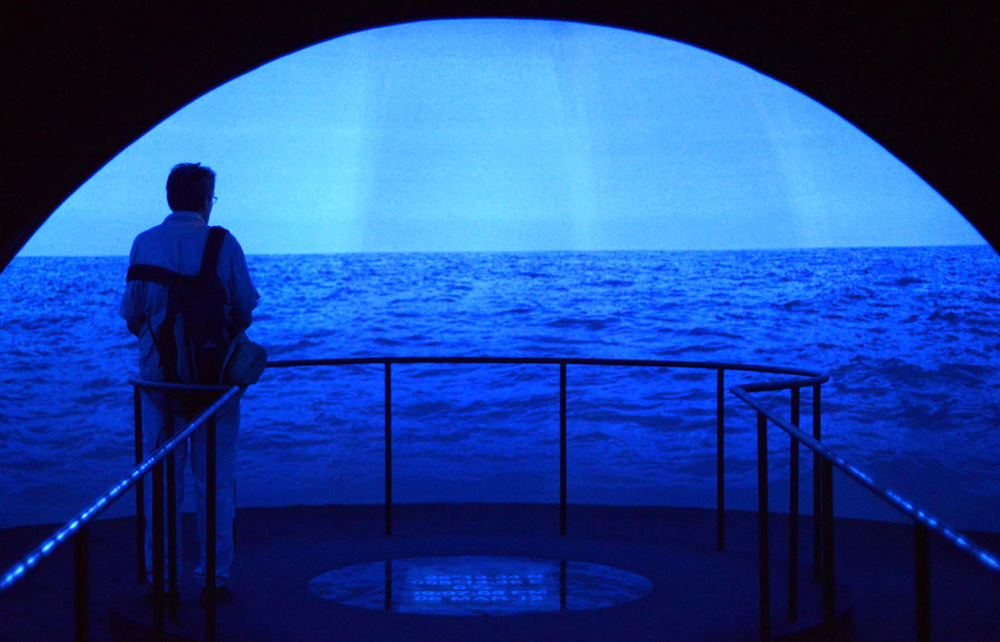
Mohammed once said to me, in one of our meetings: Most of my artworks are huge projects that require several institutions and establishments to construct. I always begin to draw the work of art and its charts and perspectives as if I was studying the project, accompanied by the theoretical matter around the idea of the artwork, its significations, and its symbolism. It is not enough to introduce the artwork stripped of explaining, unless the idea requires so. After making all the plans and explaining the ideas, there comes a stage in which we search for new ways of execution and display. During the searching phase, new questions arise and more possibilities become wide open, and the audience attends as a participating element in the creative process. This phase is followed by choosing the artwork or the exhibition curators, then choosing experts and professionals in many fields of those who could contribute to introducing the final perception about finishing the job in the best way possible and maintaining its aesthetical feature.
The Light in Between
My friendship with Mohammed Kazem goes back to 1986, and we actually have so many things in common, one of which is our love for music and Oud instrument. Only this year we introduced for the first time a mutual artistic experiment titled “The Light in Between” which was hosted by the Cultural Foundation in July 2022, and it is a mutual exhibition for us both as poet and artist, and it contained 53 paper artworks in which poetry and art mingle, and the topic of “light” is introduced via the smoothness of poetry and the technique of scratched paper.
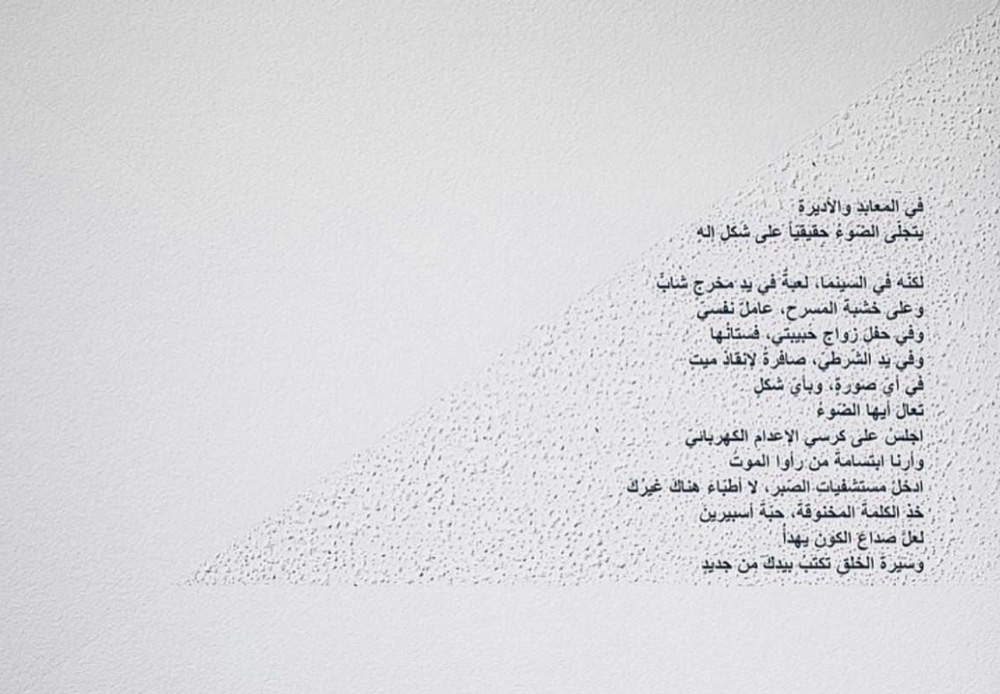
This exhibition manifests the interactive harmony between shapes and poetry, expressed by an articulate and smooth intertwining between words and recurrent scratches. This mix also signifies the sound of paper which the audience could feel through the pieces as a whole, and could connect to the poetic rhythm. The exhibition also embodies the friendship that lasted for 35 years between Kazem and I, as we have a strong artistic connection and deep understanding, and the years of conversations and personal meetings between as a poet and an artist about “light” and its many meanings, have led to naming this collection “The Light in Between” which is a reflection of the light and shadow in the two friends’ works and their embodiment on paper as a medium that displays the poetic words and embodies artistic expressions. The exhibition was curated by well-known artist Reem Fidda and was supervised by Emirati curator Aisha Al Humairi.

What makes this journey stand out is the variety of ideas and methods adopted by Kazem. among which his unique attempt at scarring paper with scissors, his paintings in “Following the Light” and installation artworks varying in colors, shapes, and artistic practices. he also enjoyed a good sense of organization as an artist, as he collected and wrote down his own personal archive, including all the articles and his participations abroad in most of the world’s biennales.
he also kept a track record of all his art pieces owned and displayed in the world’s museums, among which we mention Guggenheim Museum in New York and Pompidou in Spain. he also has a personal gallery to represent him, which is Isabelle Van Den in Alserkal Dubai, and another gallery in Europe managed by renowned artist and curator Dr. Dorothea Koelen.
A poet and writer from the 80s generation in UAE, he has published several books about art, poetry, theatre, and novel, including: “In light and shadow, and between them life”, a study on visual arts in the Emirates - Sharjah 2000.

